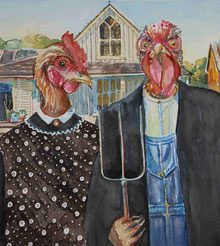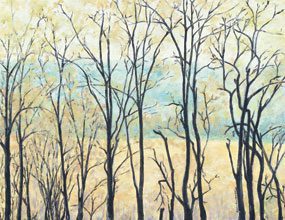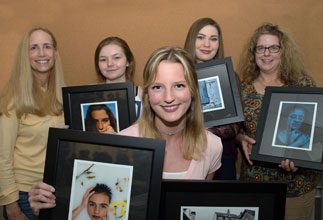The 'Small Art Town" Expert tells Lowcountry Weekly why Beaufort keeps making the cut.

The day just couldn’t be any nastier. Well, maybe if actual cats and dogs began to fall from the skies. John Villani doesn’t mind. The Santa Fe-based author is just fine sipping a cup of Common Ground coffee in shorts and a golf shirt. “I had to brush a foot of snow off my car to make it to the airport this morning,” he explains. “The rain doesn’t bother me.”
It’s bothering members of the Beaufort Guild of Galleries who have flown in the author of The 100 Best Small Art Towns in America for Kaleidescope Weekend. The weather’s just not cooperating and tonight is Art Walk and then there’s the Film Festival and the Big Chill party to consider. Villani knows that a little weather will not dampen a true art lover’s spirit. If you paint, sculpt, photograph, or perform it, they will come. Hell or high water are just minor inconveniences. To borrow a line from that aforementioned film, ìsometimes you just have to let art flow over you.” Besides, Beaufort’s in the book.
Lowcountry Weekly’s Mark Shaffer braved the gale force winds to pick Villani’s brain on the concept of an “art town” and how Beaufort fits into it.
LW: How did you get started with the 100 best art towns?
JV: Living in Santa Fe you get to see the impact of a lot of large-scale development in both the tourism and economic sectors and in the way that it changes peoples’ lives. And I applied my perspectives to visits I was making to other communities around the Southwest – I was looking around, looking around my part of the country just on holidays and day trips and weekend trips just seeing this strong impact of the arts in unexpected places. And it occurred to me after seeing this twenty or so times that this was a trend and something that was perhaps worth writing about. So, I discovered a book called 100 Best Small Towns in America, found that book, looked at it, found that it did not do anything for the arts or about the arts. It was all about quality of life issues but not about art issues. So I decided to flip it over and do a book like that but with an arts focus. So that’s how the project got started back in ‘93, I think.
LW: What has to be in place to make a great “art town?”
JV: Um, I guess just the integrity of a local arts scene that knows where it’s heading. A great art town – not all of them are great art towns – but really good ones have a sense of themselves as being different – you just can’t look at what’s going on in another community and say we’re going to cookie cutter this and apply it here and we’ll be successful. It’s not like mall development. It’s not like putting up a theater or a performing arts center. It’s a matter of happenstance; it’s a matter of some government engagement in the form of some support at different stages. But it’s really driven by entrepreneurship and enterprise – it’s really driven by the need some artists have to, um, cut their own way in life and the desire a lot of people around the arts have to… engage in the presentation or production of arts events or galleries, of art fairs, of theater companies. It has to have those components.
LW: What first drew your attention to Beaufort?
JV: Uh, let’s see… back when I was researching my earliest books I was making calls to a lot of states’ arts councils and I was asking the community development officers in these state arts councils “which towns in your state have concentrations of artists and galleries?”And it just ame to the top of the list.
LW: what sets Beaufort apart, what make sit unique?
JV: I think it’s got a very low key, accessible arts scene that is driven primarily by the galleries. That’s a very important tourist draw. It’s very important to have infrastructure where people can go from one place to another and walk around casually, stroll around town and see art wherever they turn. So Beaufort’s strength is it’s ability to present a free self-guided art tour every day of the week. And that’s a real asset… and that’s what I think makes it one of the best examples of its type of town in the country. Not every place I write about has a small population, an incredible location and this incredible variety of places you can get in and out of at your own leisure. That’s what makes it a great art town.
LW: But you also have the Sea Island Gullah cultural influence here. What does that factor in?
JV: Well, in my experience it’s been an important driver for distinguishing the community and the entire Lowcountry coastline from what the rest of this region represents. Once you get 50 miles inland it’s a whole different kind of demographic zone, but getting down here and actually being able to reach the Gullah culture, the indigenous culture of this area is hugely important in my book. I mean in my own career I work around Native American people a good bit in my part of the country where I live in New Mexico. I think it’s really vitally important that an arts scene that has a sense of its self also pays attention to it indigenous culture. You can’t just overlay and imported arts scene that doesn’t respect, pay homage to, or include the indigenous culture of an area. And here you have – to a degree you have it kind of integrated and included it into the Beaufort arts scene.
LW: So does the “culture” of the arts scene change or preserve that indigenous culture? Where does it draw the line?
JV: That really depends upon the people that are involved with it, you know? There’s a lot of pressure on some artists in some parts of the country to sell, sell, sell. And many indigenous arts circles the way the art is made you just can’t crank out the work to meet the demands of a kind of “production” approach to creating art. So I think that these indigenous cultures have to be accommodated wherever they’re found.
LW: Which brings us to the next question: where do the arts fit in to our “society of instant gratification” these days?
JV: It’s becoming… I mean the whole concept of what an art town is and what an art town represents has become an important merging point for many communities and visitors bureaus and tourist authorities who want to draw attention to different kinds of areas around the country. There’s communities from Nova Scotia to Southern California and the deserts of Arizona that are trying to leverage the presence of art as a way to drive certain types of desirable community quality of life issues upward. And so… when you have arts in a community, when you have this sort of culture that is based on opportunity, it’s sort of perceived as being a great way to evolve a community and make it a better place to live. Doesn’t always happen that way. Sometimes it happens that the community becomes a more expensive place to live, it becomes more difficult for an artist to sustain himself because of the economic cycle of success.
LW: That was my next question; how do you avoid “overkill.”
JV: Artists have to buy their own spaces. Number one: artists have to be able to invest in the places where they have decided to make their stand. It’s almost inevitable that the efforts of artists, that the elbow grease, the hard work is going to attract others. It’s going to attract entrepreneurs and investors in a certain region who are going to say, “hey, there are a lot of artists here and people coming down to see the artists. Let’s drop in a restaurant or a coffee shop or a boutique or a whatever.” So for artists to kind of avoid being dealt out of the process when that happens, they have to be able to get up and become shareholders in that arts scene and be able to profit and benefit from its rising tide.
LW: What are some of the keys to cultivating interest in a community that aspires to be an art town?
JV: There has to be a visible presence of the arts. You have to have some degree of contact point in the arts scene where people can see it, recognize it and go to it. You have to have either public art in the form of sculpture, you have to have accessible and prominently place galleries, you have to have the arts avoid being buried in a visitors’ center web site. A lot of times they get stuck under entertainment or shopping… you have to acknowledge the art community and respect it.
LW: Beaufort’s known for it’s visual arts. How do the performing arts fit in?
Theater communities and performance communities have a way of surviving difficult times. They know what it’s like to scrape together to put up a production… so they tend to be very aggressively innovative when it comes to finding place to do what they need to do whether that be the stage of a coffee shop or the proscenium of a historical vaudeville house. I think that having a performing arts momentum in a community allows it to be more diverse, allows it to be more attractive, allows it to blow more types of creative steam, whether that be classical music, the blues or Shakespeare. It’s important to have diversity of creative expression within an art town… I think Beaufort’s headed in the right direction with the film festival. If South Carolina’s going to have a film industry, it’s going to happen in a place like Beaufort.
LW: One word to sum up what makes a great, successful art town.
JV: Collaboration. Collaboration. I think that communities have to make the most of what they have available to them in terms of their existing resources. I mean you can’t just stop talking to each other, or stop planning together or stop using each other’s resources to build a better future and a better home… there has to be that initiative or sense of enterprise that extends the welcome hand out from the art community to others… with the arts you have to network. You have to present your most unified face to the community at large. So, you’ve got to get it together in the present if you’re going to have a bright future.
John Villani has written about art for the likes of Vanity Fair and Art in America, among others. His 100 Best Small Art Towns in America is in its fourth edition. He tells Lowcountry Weekly his recent visit to Beaufort “really recharged my batteries.”
Mark Shaffer is a former TV news anchor (reformed) and freelance writer. Originally from the Pee Dee area, he and his wife are happy to be back in the sun after more than three years in Seattle (yes, it really does rain that much). Always on the lookout for interesting story ideas and free meals, he can be reached at marks@lowcountryweekly.com







